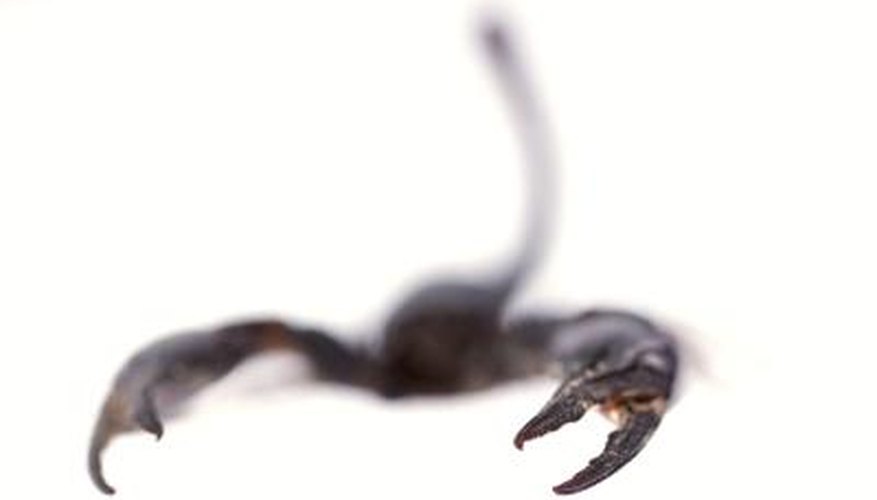The deathstalker scorpion is not your average pet. It has the power to kill a human being, making it a very poor choice for most exotic pet owners. Even though this scorpion is easy to come by in the pet trade, only the most experienced scorpion keepers should consider it as a pet. Some areas require special permits to keep them, so bear that in mind. If you still decide to keep the deathstalker scorpion as a pet, then knowing how to care for one properly can mean the difference in life and death for both you and the scorpion.
- The deathstalker scorpion is not your average pet.
- Even though this scorpion is easy to come by in the pet trade, only the most experienced scorpion keepers should consider it as a pet.
Consider the dangers of getting stung by the deathstalker scorpion. The venom is a cocktail of neurotoxins that can literally shut down your body's systems. Many people die of pulmonary oedema when stung. Children and the elderly, as well as anyone who is allergic or in poor health, are particularly susceptible to the venom's effects. Anyone stung by the scorpion can die from the sting if he is not treated promptly.
Know that the scorpion can sting from virtually any position if you come close enough. They are an incredibly fast and aggressive species and will not hesitate to sting if they feel threatened. Keep your distance at all times.
- Know that the scorpion can sting from virtually any position if you come close enough.
Understand that your new deathstalker scorpion can and will escape if you do not get a locking cage that is well put together. Do not use a cheap, homemade cage or aquarium to keep a deadly scorpion like the deathstalker. Spend the money for a high-quality, locking enclosure.
Commit to taking extra precautions when feeding the scorpion or otherwise entering its cage. This is when the majority of stings occur. Simply set up a divider that you can insert between you and the scorpion that is exactly the width and height of the inside of your enclosure. This will provide a barrier that you can trust when working in the enclosure.
Buy a five-gallon tank for the ideal enclosure. This tank size allows for plenty of height and floor space. Scorpions need room to roam, and this size is ideal for this species.
Fill the floor of the enclosure with sand, dry peat moss or topsoil to give the scorpion a nice substrate. Make the substrate about six inches deep to allow this burrowing species the ability to dig in. Misting the substrate once every couple of months with water is ideal for humidity control.
- Buy a five-gallon tank for the ideal enclosure.
- Fill the floor of the enclosure with sand, dry peat moss or topsoil to give the scorpion a nice substrate.
Add in a wide, shallow water bowl for your deathstalker scorpion. This is ideal to allow the scorpion to drink and stay cool without messing up the humidity in the enclosure. Deathstalker scorpions need about 50 per cent humidity to survive and a temperature between 21.1 and 32.2 degrees C. Adding a thermometer and hygrometer as well as a heating source is advised to help control these variables.
Adding decorations are optional, but scorpions certainly like the extra hiding spots. The deathstalker particularly likes hiding spots, and will use them if they are added. Just make certain that they are not chemically produced or carry mites.
- Adding decorations are optional, but scorpions certainly like the extra hiding spots.
Feed the deathstalker scorpion a steady diet of crickets or roaches. Other insects are fine as well, but crickets and roaches are proven winners for this species. Also ensure that you pick live food that is much smaller than the scorpion itself. Remove food that is left uneaten within one day to ensure that mites stay away.
Watch for any signs of sickness in your scorpion. Scorpions are relatively healthy pets as a rule, but they might develop sluggishness, a hesitancy to eat or even a swollen belly. All of these things are signs that something is not right. Overfeeding is the most common cause of sickness in a pet scorpion, with moulting in the wrong humidity a close second. If the humidity is not right in the enclosure, then the moult can cause loss of limbs or even death.
- Watch for any signs of sickness in your scorpion.
- Scorpions are relatively healthy pets as a rule, but they might develop sluggishness, a hesitancy to eat or even a swollen belly.
Observe your scorpion and stay out of its enclosure unless you absolutely have to go in. Do not tease or stress your scorpion. Many people think that it is funny or entertaining to get them angry. Not only is it cruel to the scorpion, it is also very dangerous with a breed such as the deathstalker.
Think twice before you decide to breed the deathstalker scorpion. They are difficult to pair up, hesitant to breed and dangerous to work with. Only the most experienced owners should consider breeding this dangerous species.
TIP
Always respect the distance between you and this scorpion. Spend the extra money to get a solid enclosure. Skip this breed unless you are an expert keeper.
WARNING
Check your local laws regarding dangerous pets before getting the deathstalker. Never take your eyes off the pet when the enclosure is open. Never be lazy about using a divider in the enclosure. Always feed the scorpion one live item at a time.
